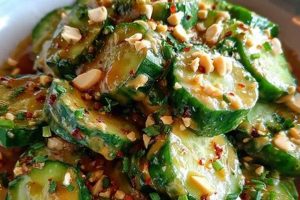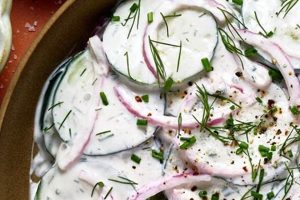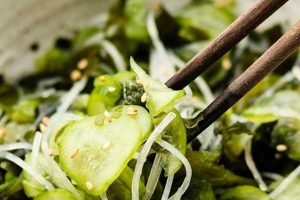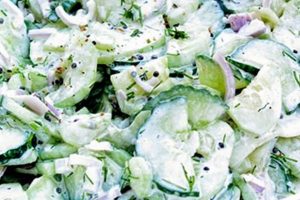A refreshing and healthy dish, this culinary creation combines the creamy texture of yogurt with the crisp coolness of cucumbers. Often enhanced with herbs like dill or mint, and spices such as garlic or cumin, this simple combination can be a light lunch, a side dish, or a component of a larger meal. Variations exist across cultures, incorporating ingredients like red onion, lemon juice, or even tomatoes for added flavor and texture.
The dish offers several nutritional advantages. Yogurt provides probiotics, beneficial for gut health, and is a source of calcium and protein. Cucumbers offer hydration and are rich in vitamins and antioxidants. Its versatility makes it adaptable to various dietary needs, easily adjusted to be vegan with plant-based yogurt alternatives or tailored to specific flavor profiles with diverse herbs and spices. This cool and refreshing salad has likely existed in various forms for centuries, especially in regions where both dairy and cucumbers are readily available.
Further exploration will cover variations on this classic combination, detailed preparation methods, tips for ingredient selection, and suggestions for serving and presentation.
Tips for a Perfect Yogurt and Cucumber Salad
Achieving optimal flavor and texture requires attention to detail. These tips offer guidance for creating a consistently successful dish.
Tip 1: Select High-Quality Yogurt: The yogurt forms the base of the salad; its quality significantly impacts the final result. Greek yogurt offers a thicker, creamier texture, while traditional yogurt provides a tangier flavor. Consider fat content as well; full-fat yogurt yields a richer salad.
Tip 2: Prepare the Cucumbers Properly: English cucumbers, with their thinner skin and fewer seeds, are ideal. For other varieties, consider peeling and seeding to prevent excess water and bitterness. Salting and draining the cucumbers beforehand removes excess moisture, preventing a watery salad.
Tip 3: Elevate with Fresh Herbs: Fresh herbs dramatically enhance the flavor profile. Dill and mint are classic choices; parsley, chives, or cilantro offer intriguing alternatives. Finely chop the herbs to release their full aroma and distribute them evenly.
Tip 4: Consider Garlic and Spices: A small amount of minced garlic adds a pungent note. Ground cumin, coriander, or even a pinch of red pepper flakes introduce complexity and depth. Start with small amounts and adjust according to preference.
Tip 5: Balance Acidity: A touch of acidity brightens the flavors. Lemon juice, white wine vinegar, or even a splash of red wine vinegar work well. Taste and adjust the acidity to achieve a harmonious balance.
Tip 6: Enhance with Texture: Toasted nuts, such as pine nuts or walnuts, provide a satisfying crunch. Crumbled feta cheese or chopped olives add a salty, savory element.
Tip 7: Chill Before Serving: Allow the salad to chill in the refrigerator for at least 30 minutes before serving. This allows the flavors to meld and enhances the refreshing quality of the dish.
By following these guidelines, one can create a consistently delicious and refreshing salad. Attention to detail, from ingredient selection to chilling time, elevates this simple dish.
The following section will provide a selection of variations on this classic recipe, demonstrating its adaptability and versatility.
1. Fresh Ingredients
The quality of a yogurt and cucumber salad hinges directly on the freshness of its components. Fresh ingredients elevate this simple dish, maximizing flavor, texture, and overall enjoyment. Subpar or aging ingredients can detract significantly from the final result.
- Yogurt Selection
Yogurt provides the foundational creaminess and tang. Fresh, high-quality yogurt, whether Greek or traditional, contributes a clean, vibrant flavor. Look for yogurt with a recent expiration date and a pleasant, slightly tart aroma. Avoid yogurt with any off-odors or signs of separation. The choice between full-fat, low-fat, or non-fat yogurt influences the richness and texture of the salad.
- Cucumber Quality
Crisp, firm cucumbers are essential. Look for cucumbers that are vibrantly green and free from blemishes or soft spots. Different cucumber varieties, such as English, Persian, or garden cucumbers, offer variations in flavor and texture. English cucumbers, known for their thin skin and minimal seeds, are often preferred for salads.
- Herbaceous Elements
Fresh herbs significantly enhance the flavor profile. Dill and mint are classic pairings, offering bright, aromatic notes. Other herbs like parsley, chives, or cilantro can also complement the cucumber and yogurt. Wilted or dried herbs lack the vibrancy and aromatic intensity of fresh herbs, impacting the overall sensory experience.
- Optional Additions
Other fresh ingredients, like garlic, red onion, or tomatoes, can further enhance the salad. When incorporating these additions, freshness remains paramount. Choose firm, pungent garlic cloves, crisp red onions with a bright color, and ripe, juicy tomatoes. These additions, when fresh, contribute layers of flavor and texture.
Prioritizing fresh, high-quality ingredients ensures a vibrant and flavorful yogurt and cucumber salad. The interplay of these fresh components contributes to a delightful culinary experience, highlighting the importance of ingredient selection in achieving optimal results.
2. Proper Drainage
Excess moisture significantly detracts from the textural and flavor integrity of a yogurt and cucumber salad. Proper drainage techniques are essential for achieving a desirable consistency and preventing a watery, diluted final product. Implementing effective drainage methods ensures the flavors of the yogurt, herbs, and spices remain vibrant and undiluted.
- Salting and Resting
Salting sliced cucumbers draws out excess moisture through osmosis. After salting, allowing the cucumbers to rest in a colander for a period, typically 15-30 minutes, facilitates the release of water. This process significantly reduces the water content of the cucumbers, preventing a watery salad and ensuring the yogurt base maintains its desired consistency. The salt also lightly seasons the cucumbers.
- Thorough Drying
After salting and resting, gently patting the cucumber slices dry with paper towels or a clean kitchen towel further removes residual moisture. This step ensures optimal texture and prevents the salad from becoming diluted. Thorough drying maximizes the crispness of the cucumbers while minimizing their water contribution to the overall dish. This contributes to a more balanced flavor profile, allowing the nuances of the other ingredients to shine through.
- Seed Removal (Optional)
While not strictly drainage, removing the seeds from cucumbers, especially from larger varieties, reduces the potential for excess water and bitterness. Seeds contain a higher concentration of water and can sometimes impart a slightly bitter flavor. Seed removal contributes to a cleaner, crisper texture and a more balanced flavor profile. This is particularly relevant when using cucumbers that are not specifically bred for salads, such as standard garden cucumbers.
- Yogurt Selection
While not a direct drainage technique, selecting thicker yogurts, such as Greek yogurt, contributes to a more robust base less susceptible to thinning from residual cucumber moisture. Greek yogurt, due to its straining process, has a lower water content than traditional yogurt. This higher concentration of solids provides a thicker, creamier texture that holds up well when combined with other ingredients, even if some moisture remains in the cucumbers. This choice contributes to the overall textural integrity of the salad.
By employing these drainage techniques, the final yogurt and cucumber salad achieves optimal texture and flavor. The absence of excess moisture ensures the yogurt maintains its creamy consistency, the cucumbers retain their crispness, and the flavors of the herbs and spices are not diluted, creating a refreshing and flavorful culinary experience.
3. Flavor Balance
Flavor balance is paramount in a successful yogurt and cucumber salad recipe. This dish, inherently simple in its composition, relies on a harmonious interplay of flavors to create a complex and satisfying sensory experience. The inherent coolness and mildness of cucumbers and yogurt provide a neutral canvas, requiring careful consideration of contrasting and complementary flavors to achieve a well-rounded profile. Without proper balance, the salad can be bland or, conversely, dominated by a single overpowering element.
The primary flavor components to consider include: richness, acidity, saltiness, herbaceousness, and spice. The richness of the yogurt, influenced by its fat content, establishes the foundation. Acidity, introduced through lemon juice or vinegar, cuts through the richness and brightens the overall flavor. Salt enhances the inherent flavors of the cucumbers and yogurt while also balancing the acidity. Fresh herbs contribute aromatic complexity and herbaceous notes, while spices, if used, add depth and warmth. A classic example of flavor balance in this context is the combination of creamy Greek yogurt, crisp cucumber, bright lemon juice, salty feta cheese, and aromatic dill. The interplay of these elements creates a dynamic and flavorful salad. Conversely, omitting the acidity would result in a flat, less vibrant dish. Over-salting could mask the delicate flavors of the cucumber and yogurt. An overabundance of herbs could overwhelm the palate.
Achieving flavor balance requires both precise measurements and subjective taste adjustments. While recipes provide a starting point, individual palates vary, and adjustments may be necessary to achieve optimal results. Tasting and adjusting seasonings throughout the preparation process are essential. The goal is not to achieve a perfect equilibrium where all flavors are equally intense, but rather a harmonious integration where each element contributes to the overall experience without overpowering the others. This careful orchestration of flavors elevates the simple combination of yogurt and cucumbers into a sophisticated and refreshing culinary creation.
4. Chilling Time
Chilling time plays a crucial role in the final quality of a yogurt and cucumber salad. This period of refrigeration, typically a minimum of 30 minutes, allows several key processes to occur that enhance both the flavor and texture of the dish. Lowering the temperature suppresses bacterial growth, maintaining food safety and preserving freshness. More importantly, chilling allows the flavors of the various componentsyogurt, cucumbers, herbs, spices, and acidic elementsto meld and harmonize. This integration of flavors creates a more cohesive and complex taste profile compared to a freshly made, unchilled salad. The chilling process also enhances the refreshing quality of the dish, making it particularly appealing in warmer weather. Consider the example of a salad prepared with freshly chopped dill. Immediately after preparation, the dill flavor might be somewhat sharp and assertive. After chilling, the dill flavor mellows and integrates with the other ingredients, creating a more balanced and nuanced flavor profile.
The practical significance of understanding the importance of chilling time lies in the ability to optimize the sensory experience of the salad. Serving the salad immediately after preparation results in a less developed flavor profile and a less refreshing experience. Furthermore, inadequate chilling can compromise food safety, particularly if the salad contains ingredients prone to bacterial growth. Consider the scenario of a picnic or outdoor gathering where the salad is transported and served without proper chilling. Not only will the flavors be less developed, but the risk of bacterial contamination also increases. Therefore, factoring in sufficient chilling time is crucial for both maximizing flavor and ensuring food safety. Chilling also allows the cucumbers to become firmer, enhancing their textural appeal.
In summary, chilling time is not merely a passive waiting period but an active stage in the development of a yogurt and cucumber salad. It allows for flavor integration, enhances the refreshing quality, improves food safety, and contributes to optimal textural appeal. Recognizing the importance of this step ensures the final product reaches its full potential, transforming a simple combination of ingredients into a truly delightful culinary experience.
5. Versatile Serving
The adaptability of a yogurt and cucumber salad recipe extends beyond ingredient variations to its versatile serving options. This quality enhances its suitability for diverse culinary contexts, from casual meals to formal occasions. Understanding these varied applications underscores the dish’s practicality and broad appeal.
- Standalone Side Dish
The salad functions effectively as a refreshing side dish, complementing a wide range of main courses. Its cool, creamy texture and bright flavors provide a counterpoint to richer, heavier dishes, such as grilled meats or roasted vegetables. The simplicity of the salad also allows it to share the table with more complex side dishes without competing for attention.
- Light Lunch or Snack
The inherent lightness and nutritional value of the salad make it a suitable choice for a light lunch or snack. Its combination of protein, healthy fats, and hydrating vegetables offers satiety without heaviness. This makes it an appealing option for those seeking a quick, nutritious meal. The salad can be easily portioned and transported, making it convenient for work lunches or picnics.
- Component of Larger Meals
This salad seamlessly integrates into larger, multi-component meals. It can be incorporated into a mezze platter, contributing a refreshing element alongside other dips, salads, and appetizers. It also works well as a component within buffet-style meals, offering a lighter option among heavier dishes. Its adaptability to different serving formats expands its utility in diverse culinary settings.
- Base for Elaborations
While delicious on its own, the salad can serve as a base for further culinary elaborations. Grilled chicken or fish can be added for a more substantial meal. Grains, such as quinoa or couscous, can be incorporated for added texture and nutrients. These additions transform the simple salad into a more complex and complete dish, demonstrating its versatility as a culinary foundation.
The versatility of serving options contributes significantly to the enduring appeal of the yogurt and cucumber salad. Its ability to function as a side dish, a light meal, a component of larger spreads, or a base for further culinary exploration makes it a valuable addition to any repertoire. This adaptability ensures its relevance across a wide spectrum of dining occasions, solidifying its place as a culinary staple.
Frequently Asked Questions
This section addresses common inquiries regarding yogurt and cucumber salad preparation, offering concise and informative responses to clarify potential uncertainties and enhance understanding of optimal techniques.
Question 1: What type of yogurt is best suited for this salad?
Greek yogurt, due to its thicker consistency, creates a creamier salad. However, traditional yogurt offers a tangier flavor profile. The choice depends on individual preference.
Question 2: How can excess moisture in the salad be prevented?
Salting and draining the cucumbers prior to combining them with the yogurt is crucial. This process draws out excess water and prevents a watery salad. Thoroughly patting the cucumbers dry further minimizes moisture.
Question 3: What herbs pair well with cucumber and yogurt?
Dill and mint are classic choices, offering bright, refreshing notes. Parsley, chives, and cilantro also complement the flavors of the salad. Experimentation with various herbs can yield interesting flavor profiles.
Question 4: Can other ingredients be added to this salad?
Certainly. Chopped red onion, tomatoes, or crumbled feta cheese can enhance the flavor and texture. Toasted nuts or seeds can add a satisfying crunch. Adjustments should consider overall flavor balance.
Question 5: How long should the salad be chilled before serving?
Chilling for at least 30 minutes allows the flavors to meld and enhances the refreshing quality. Longer chilling times, up to a few hours, are acceptable, but avoid extended periods to maintain optimal cucumber texture.
Question 6: How long can the salad be stored in the refrigerator?
Properly stored in an airtight container, the salad typically remains fresh for up to three days. However, the texture of the cucumbers may soften over time.
Careful attention to these details ensures a consistently successful and enjoyable culinary experience.
The following section will provide a collection of recipe variations, demonstrating the adaptability of this dish to diverse flavor preferences and dietary needs.
Yogurt and Cucumber Salad Recipe
This exploration has detailed the essential aspects of creating a successful yogurt and cucumber salad recipe. From the importance of fresh, high-quality ingredients and proper drainage techniques to the crucial role of flavor balance and chilling time, each step contributes significantly to the final product. The versatility of this dish, adaptable to various serving occasions and culinary contexts, further enhances its value. Understanding these elements allows for consistent preparation of a refreshing, flavorful, and texturally appealing salad.
The simplicity of this recipe belies its potential for culinary creativity. Encouraging experimentation with ingredient variations, flavor combinations, and presentation styles unlocks a wealth of possibilities. Further exploration and adaptation of this classic combination promise continued culinary enjoyment and discovery.






